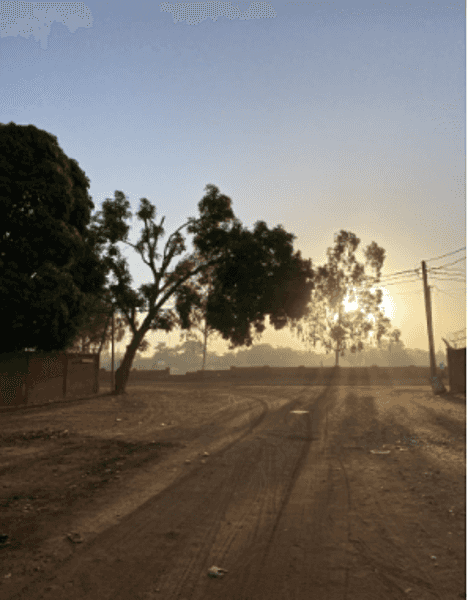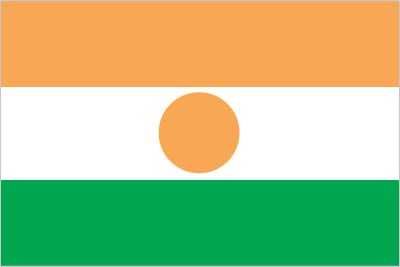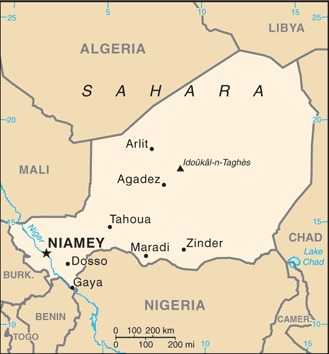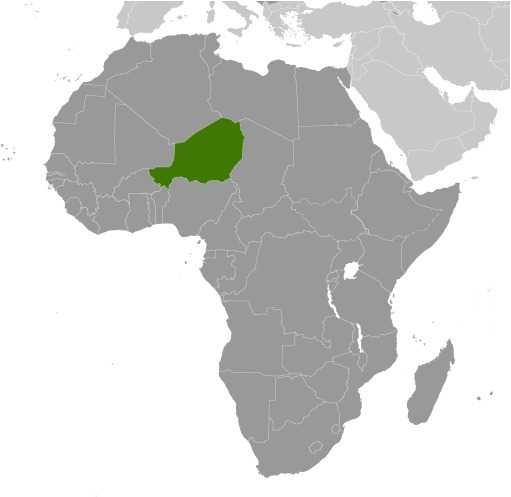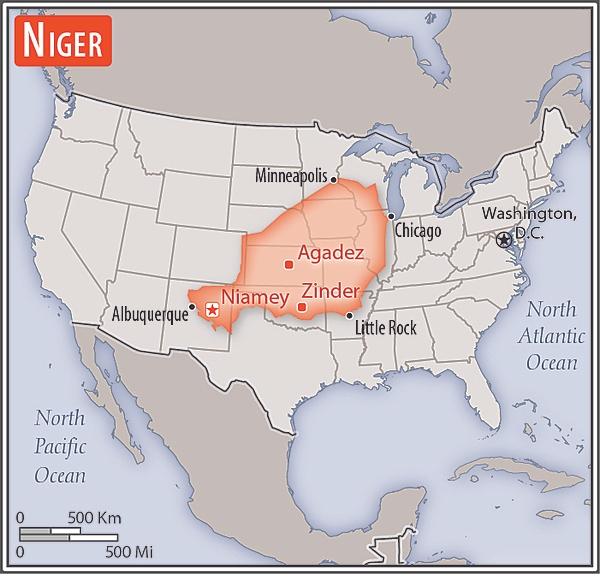Introduction
Background
Nomadic peoples from the Saharan north and agriculturalists from the south settled present-day Niger. The Taureg kingdom of Takedda was one of the largest kingdoms in the north and played a prominent role in regional trade in the 14th century. In the south, the primary ethnic groups were the Songhai-Zarma in the west, the Hausa in the center, and the Kanuri in the east. When European colonizers arrived in the 19th century, the region was an assemblage of disparate local kingdoms.
In the late 19th century, the British and French agreed to partition the middle regions of the Niger River, and France began its conquest of what would become the colony of Niger. France experienced determined local resistance -- particularly during the Tuareg uprising (1916-1917) -- but established a colonial administration in 1922.
After achieving independence from France in 1960, Niger experienced single-party or military rule until 1991, when political pressure forced General Ali SAIBOU to allow multiparty elections. Political infighting and democratic backsliding led to coups in 1996 and 1999. In 1999, military officers restored democratic rule and held elections that brought Mamadou TANDJA to power. TANDJA was reelected in 2004 and spearheaded a 2009 constitutional amendment allowing him to extend his presidential term. In 2010, military officers led another coup that deposed TANDJA. ISSOUFOU Mahamadou was elected in 2011 and reelected in 2016. In 2021, BAZOUM Mohamed won the presidential election, marking Niger’s first transition from one democratically elected president to another. Nonetheless, a military junta led by General Abdourahamane TIANI once again seized power in July 2023, detaining President BAZOUM and announcing the creation of a National Council for the Safeguarding of the Homeland (CNSP).
Niger is one of the poorest countries in the world with minimal government services and insufficient funds to develop its resource base. It is ranked fourth to last in the world on the UN Development Program's Human Development Index of 2023/2024. The largely agrarian and subsistence-based economy is frequently disrupted by extended droughts common to the Sahel region of Africa. The Nigerien Government continues its attempts to diversify the economy through increased oil production and mining projects. In addition, Niger is facing increased security concerns on its borders from various external threats including insecurity in Libya, spillover from the conflict and terrorism in Mali, and violent extremism in northeastern Nigeria.
Visit the Definitions and Notes page to view a description of each topic.
Geography
Location
Western Africa, southeast of Algeria
Geographic coordinates
16 00 N, 8 00 E
Map references
Africa
Land boundaries
total: 5,834 km
border countries (7): Algeria 951 km; Benin 277 km; Burkina Faso 622 km; Chad 1,196 km; Libya 342 km; Mali 838 km; Nigeria 1,608 km
Coastline
0 km (landlocked)
Maritime claims
none (landlocked)
Climate
desert; mostly hot, dry, dusty; tropical in extreme south
Terrain
predominately desert plains and sand dunes; flat to rolling plains in south; hills in north
Elevation
highest point: Idoukal-n-Taghes 2,022 m
lowest point: Niger River 200 m
mean elevation: 474 m
Natural resources
uranium, coal, iron ore, tin, phosphates, gold, molybdenum, gypsum, salt, petroleum
Land use
agricultural land: 35.1% (2018 est.)
arable land: 12.3% (2018 est.)
permanent crops: 0.1% (2018 est.)
permanent pasture: 22.7% (2018 est.)
forest: 1% (2018 est.)
other: 63.9% (2018 est.)
Irrigated land
2,666 sq km (2020)
Major lakes (area sq km)
fresh water lake(s): Lake Chad (endorheic lake shared with Chad, Nigeria, and Cameroon) - 10,360-25,900 sq km
note - area varies by season and year to year
Major rivers (by length in km)
Niger (shared with Guinea [s], Mali, Benin, and Nigeria [m]) - 4,200 km
note – [s] after country name indicates river source; [m] after country name indicates river mouth
Major watersheds (area sq km)
Atlantic Ocean drainage: Niger (2,261,741 sq km)
Internal (endorheic basin) drainage: Lake Chad (2,497,738 sq km)
Major aquifers
Lake Chad Basin, Lullemeden-Irhazer Basin, Murzuk-Djado Basin
Population distribution
majority of the populace is located in the southernmost extreme of the country along the border with Nigeria and Benin as shown in this population distribution map
Natural hazards
recurring droughts
Geography - note
landlocked; one of the hottest countries in the world; northern four-fifths is desert, southern one-fifth is savanna, suitable for livestock and limited agriculture
People and Society
Population
total: 26,342,784
male: 13,056,203
female: 13,286,581 (2024 est.)
comparison rankings: female 56; male 55; total 55
Nationality
noun: Nigerien(s)
adjective: Nigerien
Ethnic groups
Hausa 53.1%, Zarma/Songhai 21.2%, Tuareg 11%, Fulani (Peuhl) 6.5%, Kanuri 5.9%, Gurma 0.8%, Arab 0.4%, Tubu 0.4%, other/unavailable 0.9% (2006 est.)
Languages
Hausa, Zarma, French (official), Fufulde, Tamashek, Kanuri, Gurmancema, Tagdal
note: represents the most-spoken languages; Niger has 10 national languages: Arabic, Buduma, Fulfuldé, Guimancema, Hausa, Kanuri, Sonay-Zarma, Tamajaq, Tassawaq, and Tubu
Religions
Muslim 95.5%, ethnic religionist 4.1%, Christian 0.3%, agnostics and other 0.1% (2020 est.)
Demographic profile
Niger has the highest total fertility rate (TFR) of any country in the world, averaging close to 7 children per woman in 2022. A slight decline in fertility over the last few decades has stalled. This leveling off of the high fertility rate is in large part a product of the continued desire for large families. In Niger, the TFR is lower than the desired fertility rate, which makes it unlikely that contraceptive use will increase. The high TFR sustains rapid population growth and a large youth population – almost 70% of the populace is under the age of 25, as of 2020. Gender inequality, including a lack of educational opportunities for women and early marriage and childbirth, also contributes to high population growth.
Because of large family sizes, children are inheriting smaller and smaller parcels of land. The dependence of most Nigeriens on subsistence farming on increasingly small landholdings, coupled with declining rainfall and the resultant shrinkage of arable land, are all preventing food production from keeping up with population growth.
For more than half a century, Niger's lack of economic development has led to steady net outmigration. In the 1960s, Nigeriens mainly migrated to coastal West African countries to work on a seasonal basis. Some headed to Libya and Algeria in the 1970s to work in the booming oil industry until its decline in the 1980s. Since the 1990s, the principal destinations for Nigerien labor migrants have been West African countries, especially Burkina Faso and Cote d’Ivoire, while emigration to Europe and North America has remained modest. During the same period, Niger’s desert trade route town Agadez became a hub for West African and other Sub-Saharan migrants crossing the Sahara to North Africa and sometimes onward to Europe.
More than 60,000 Malian refugees have fled to Niger since violence between Malian government troops and armed rebels began in early 2012. Ongoing attacks by the Boko Haram Islamist insurgency, dating to 2013 in northern Nigeria and February 2015 in southeastern Niger, pushed tens of thousands of Nigerian refugees and Nigerien returnees across the border to Niger and displaced thousands of locals in Niger’s already impoverished Diffa region.
Age structure
0-14 years: 49.5% (male 6,567,460/female 6,463,877)
15-64 years: 47.8% (male 6,146,355/female 6,451,574)
65 years and over: 2.7% (2024 est.) (male 342,388/female 371,130)
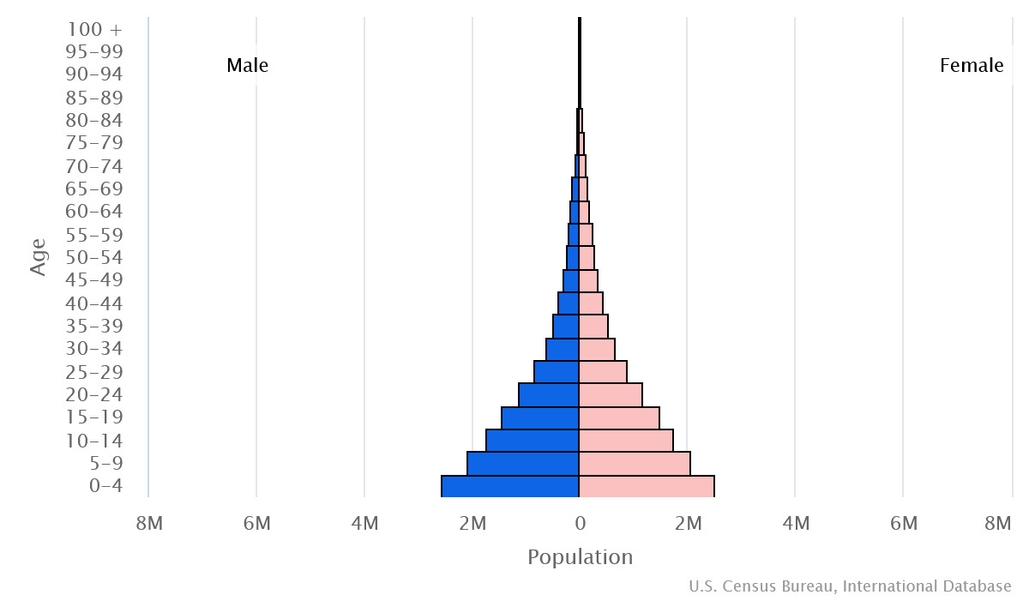
Dependency ratios
total dependency ratio: 105.4
youth dependency ratio: 100.4
elderly dependency ratio: 5
potential support ratio: 20.1 (2021 est.)
Median age
total: 15.2 years (2024 est.)
male: 14.9 years
female: 15.6 years
comparison ranking: total 229
Population distribution
majority of the populace is located in the southernmost extreme of the country along the border with Nigeria and Benin as shown in this population distribution map
Urbanization
urban population: 17.1% of total population (2023)
rate of urbanization: 4.72% annual rate of change (2020-25 est.)
Major urban areas - population
1.437 million NIAMEY (capital) (2023)
Sex ratio
at birth: 1.03 male(s)/female
0-14 years: 1.02 male(s)/female
15-64 years: 0.95 male(s)/female
65 years and over: 0.92 male(s)/female
total population: 0.98 male(s)/female (2024 est.)
Mother's mean age at first birth
18.5 years (2012 est.)
note: data represents median age at first birth among women 20-49
Infant mortality rate
total: 64.3 deaths/1,000 live births (2024 est.)
male: 69.2 deaths/1,000 live births
female: 59.2 deaths/1,000 live births
comparison ranking: total 6
Life expectancy at birth
total population: 60.9 years (2024 est.)
male: 59.3 years
female: 62.5 years
comparison ranking: total population 218
Gross reproduction rate
3.27 (2024 est.)
Contraceptive prevalence rate
11% (2021)
Drinking water source
improved: urban: 95.8% of population
rural: 63.1% of population
total: 68.6% of population
unimproved: urban: 4.2% of population
rural: 36.9% of population
total: 31.4% of population (2020 est.)
Current health expenditure
6.2% of GDP (2020)
Physician density
0.04 physicians/1,000 population (2020)
Hospital bed density
0.4 beds/1,000 population (2017)
Sanitation facility access
improved: urban: 81.9% of population
rural: 13.5% of population
total: 24.8% of population
unimproved: urban: 18.1% of population
rural: 86.5% of population
total: 75.2% of population (2020 est.)
Major infectious diseases
degree of risk: very high (2023)
food or waterborne diseases: bacterial and protozoal diarrhea, hepatitis A, and typhoid fever
vectorborne diseases: malaria, dengue fever, and sexually transmitted diseases: hepatitis B (2024)
water contact diseases: schistosomiasis
animal contact diseases: rabies
respiratory diseases: meningococcal meningitis
note: on 31 August 2023, the US Centers for Disease Control and Prevention (CDC) issued a Travel Alert for polio in Africa; Niger is currently considered a high risk to travelers for circulating vaccine-derived polioviruses (cVDPV); vaccine-derived poliovirus (VDPV) is a strain of the weakened poliovirus that was initially included in oral polio vaccine (OPV) and that has changed over time and behaves more like the wild or naturally occurring virus; this means it can be spread more easily to people who are unvaccinated against polio and who come in contact with the stool or respiratory secretions, such as from a sneeze, of an “infected” person who received oral polio vaccine; the CDC recommends that before any international travel, anyone unvaccinated, incompletely vaccinated, or with an unknown polio vaccination status should complete the routine polio vaccine series; before travel to any high-risk destination, the CDC recommends that adults who previously completed the full, routine polio vaccine series receive a single, lifetime booster dose of polio vaccine
Alcohol consumption per capita
total: 0.11 liters of pure alcohol (2019 est.)
beer: 0.04 liters of pure alcohol (2019 est.)
wine: 0.01 liters of pure alcohol (2019 est.)
spirits: 0.06 liters of pure alcohol (2019 est.)
other alcohols: 0 liters of pure alcohol (2019 est.)
comparison ranking: total 177
Tobacco use
total: 7.4% (2020 est.)
male: 13.7% (2020 est.)
female: 1.1% (2020 est.)
comparison ranking: total 154
Currently married women (ages 15-49)
80.3% (2023 est.)
Literacy
definition: age 15 and over can read and write
total population: 37.3%
male: 45.8%
female: 29% (2018)
School life expectancy (primary to tertiary education)
total: 6 years
male: 7 years
female: 6 years (2017)
Environment
Environment - current issues
overgrazing; soil erosion; deforestation; desertification; contaminated water; inadequate potable water; wildlife populations (such as elephant, hippopotamus, giraffe, and lion) threatened because of poaching and habitat destruction
Environment - international agreements
party to: Biodiversity, Climate Change, Climate Change-Kyoto Protocol, Climate Change-Paris Agreement, Comprehensive Nuclear Test Ban, Desertification, Endangered Species, Environmental Modification, Hazardous Wastes, Law of the Sea, Nuclear Test Ban, Ozone Layer Protection, Wetlands
signed, but not ratified: none of the selected agreements
Climate
desert; mostly hot, dry, dusty; tropical in extreme south
Land use
agricultural land: 35.1% (2018 est.)
arable land: 12.3% (2018 est.)
permanent crops: 0.1% (2018 est.)
permanent pasture: 22.7% (2018 est.)
forest: 1% (2018 est.)
other: 63.9% (2018 est.)
Urbanization
urban population: 17.1% of total population (2023)
rate of urbanization: 4.72% annual rate of change (2020-25 est.)
Food insecurity
widespread lack of access: due to internal conflict, high food prices, and floods - about 2.87 million people are projected to be acutely food insecure during the June to August 2023 lean season period; this would be an improvement on the situation in 2022, mostly reflecting the sharp upturn in crop yields following the below‑average cereal output in 2021; persistent insecurity continues to disrupt livelihoods and has displaced over 360,000 people as of January 2023, mostly in the Diffa, Tahoua and Tillabery regions; high food prices, as well as the floods in 2022 that affected about 327,000 people, are additional factors that have aggravated food insecurity (2023)
Air pollutants
particulate matter emissions: 50.15 micrograms per cubic meter (2019 est.)
carbon dioxide emissions: 2.02 megatons (2016 est.)
methane emissions: 22.99 megatons (2020 est.)
Waste and recycling
municipal solid waste generated annually: 1,865,646 tons (1993 est.)
municipal solid waste recycled annually: 74,626 tons (2005 est.)
percent of municipal solid waste recycled: 4% (2005 est.)
Major lakes (area sq km)
fresh water lake(s): Lake Chad (endorheic lake shared with Chad, Nigeria, and Cameroon) - 10,360-25,900 sq km
note - area varies by season and year to year
Major rivers (by length in km)
Niger (shared with Guinea [s], Mali, Benin, and Nigeria [m]) - 4,200 km
note – [s] after country name indicates river source; [m] after country name indicates river mouth
Major watersheds (area sq km)
Atlantic Ocean drainage: Niger (2,261,741 sq km)
Internal (endorheic basin) drainage: Lake Chad (2,497,738 sq km)
Major aquifers
Lake Chad Basin, Lullemeden-Irhazer Basin, Murzuk-Djado Basin
Total water withdrawal
municipal: 190 million cubic meters (2020 est.)
industrial: 40 million cubic meters (2020 est.)
agricultural: 2.35 billion cubic meters (2020 est.)
Total renewable water resources
34.05 billion cubic meters (2020 est.)
Government
Country name
conventional long form: Republic of Niger
conventional short form: Niger
local long form: Republique du Niger
local short form: Niger
etymology: named for the Niger River that passes through the southwest of the country; from a native term "Ni Gir" meaning "River Gir"
note: pronounced nee-zhair
Government type
formerly, semi-presidential republic
Note: on 26 July 2023, the National Council for the Safeguard of the Homeland, a military junta which took control of Niger's government, dissolved all government institutions, and rules by decree
Capital
name: Niamey
geographic coordinates: 13 31 N, 2 07 E
time difference: UTC+1 (6 hours ahead of Washington, DC, during Standard Time)
etymology: according to tradition, the site was originally a fishing village named after a prominent local tree referred to as "nia niam"
Administrative divisions
7 regions (regions, singular - region) and 1 capital district* (communaute urbaine); Agadez, Diffa, Dosso, Maradi, Niamey*, Tahoua, Tillaberi, Zinder
Independence
3 August 1960 (from France)
National holiday
Republic Day, 18 December (1958); note - commemorates the founding of the Republic of Niger which predated independence from France in 1960
Constitution
history: several previous; passed by referendum 31 October 2010, entered into force 25 November 2010
amendments: formerly proposed by the president of the republic or by the National Assembly; consideration of amendments requires at least three-fourths majority vote by the Assembly; passage requires at least four-fifths majority vote; if disapproved, the proposed amendment is dropped or submitted to a referendum; constitutional articles on the form of government, the multiparty system, the separation of state and religion, disqualification of Assembly members, amendment procedures, and amnesty of participants in the 2010 coup cannot be amended; amended 2011, 2017
Note: on 26 July 2023, the National Council for the Safeguard of the Homeland, a military junta which took control of Niger's government, dissolved the country's constitution
Legal system
note - following the 26 July 2023 military coup, the National Council for the Safeguard of the Homeland assumed control of all government institutions and rules by decree; formerly, mixed legal system of civil law, based on French civil law, Islamic law, and customary law
International law organization participation
has not submitted an ICJ jurisdiction declaration; accepts ICCt jurisdiction
Citizenship
citizenship by birth: no
citizenship by descent only: at least one parent must be a citizen of Niger
dual citizenship recognized: yes
residency requirement for naturalization: unknown
Suffrage
18 years of age; universal
Executive branch
chief of state: President of the National Council for the Safeguard of the Homeland (CNSP) General Abdourahame TIANI (since 28 July 2023)
head of government: CNSP Prime Minister Ali Mahaman Lamine ZEINE (since 9 August 2023)
cabinet: Cabinet appointed by the CNSP; Cabinet previously appointed by the elected president
elections/appointments: the CNSP rules by decree; previously, the president directly elected by absolute majority popular vote in 2 rounds if needed for a 5-year term (eligible for a second term); election last held on 27 December 2020 with a runoff held on 21 February 2021 (next election was to be held in 2025); prime minister appointed by the president, authorized by the National Assembly
election results:
2020/2021: Mohamed BAZOUM elected president in second round; percent of vote in first round - Mohamed BAZOUM (PNDS-Tarrayya) 39.3%, Mahamane OUSMANE (MODEN/FA Lumana Africa) 17%, Seini OUMAROU (MNSD-Nassara) 9%, Albade ABOUDA (MPR-Jamhuriya) 7.1%, other 27.6%; percent of vote in second round - Mohamed BAZOUM 55.7%, Mahamane OUSMANE 44.3%
2016: ISSOUFOU Mahamadou reelected president in second round; percent of vote in first round - ISSOUFOU Mahamadou (PNDS-Tarrayya) 48.6%, Hama AMADOU (MODEN/FA Lumana Africa) 17.8%, Seini OUMAROU (MNSD-Nassara) 11.3%, other 22.3%; percent of vote in second round - ISSOUFOU Mahamadou 92%, Hama AMADOU 8%
note: deposed president BAZOUM has been under house arrest since a military coup on 26 July 2023
Legislative branch
description: formerly the unicameral National Assembly (171 statutory seats - 166 currently; 158 members directly elected from 8 multi-member constituencies in 7 regions and Niamey by party-list proportional representation, 8 reserved for minorities elected in special single-seat constituencies by simple majority vote, 5 seats reserved for Nigeriens living abroad - 1 seat per continent - elected in single-seat constituencies by simple majority vote; members serve 5-year terms)
elections: last held on 27 December 2020 (prior to the military coup, next elections were to be held in December 2025)
election results: percent of vote by party - PNDS-Tarrayya 37%, MODEN/FA Lumana 8.7%, MPR-Jamhuriya 7.6%, MNSD-Nassara 6.8%, RDR-Tchanji 4.4%, CPR-Inganci 4.2%, MPN-Kishin Kassa 4%, PJP Generation Dubara 2.9%, ANDP Zaman Lahya 2.5%, RPP Farrilla 2.1%, ARD Adaltchi-Mutuntchi 1.7%, AMEN AMIN 1.4%, MDEN Falala 1.4%, other 15.3%; seats by party - PNDS-Tarrayya 79, MODEN/FA Lumana 19, MPR-Jamhuriya 14, MNSD-Nassara 13, CPR-Inganci 8, MPN-Kishin Kassa 6, ANDP-Zaman Lahiya 3, RPP Farrilla 2, PJP Generation Dubara 2, ARD Adaltchi-Mutuntchi 2, AMEN AMIN 2, other 16; composition - men 115, women 51, percentage women 30.7%
Note: on 26 July 2023, the National Council for the Safeguard of the Homeland, a military junta which took control of Niger's government, dissolved the National Assembly
Judicial branch
highest court(s): formerly the Constitutional Court (consists of 7 judges); High Court of Justice (consists of 7 members)
judge selection and term of office: formerly, Constitutional Court judges nominated/elected - 1 by the president of the Republic, 1 by the president of the National Assembly, 2 by peer judges, 2 by peer lawyers, 1 law professor by peers, and 1 from within Nigerien society; all appointed by the president; judges serve 6-year nonrenewable terms with one-third of membership renewed every 2 years; High Judicial Court members selected from among the legislature and judiciary; members serve 5-year terms
subordinate courts: formerly, Court of Cassation; Council of State; Court of Finances; various specialized tribunals and customary courts
Note: on 26 July 2023, the National Council for the Safeguard of the Homeland, a military junta which took control of Niger's government, dissolved the country's judicial system
Political parties and leaders
Alliance for Democracy and the Republic
Alliance for Democratic Renewal or ARD-Adaltchi-Mutuntchi [Laouan MAGAGI]
Alliance of Movements for the Emergence of Niger or AMEN AMIN [Omar Hamidou TCHIANA]
Congress for the Republic or CPR-Inganci [Maradi Kassoum MOCTAR]
Democratic Alternation for Equity in Niger
Democratic and Republican Renewal-RDR-Tchanji [Mahamane OUSMANE]
Democratic Movement for the Emergence of Niger Falala [Tidjani Idrissa ABDOULKADRI]
Democratic Patriots' Rally or RPD Bazara [Yahouza SADISSOU]
National Movement for the Development of Society-Nassara or MNSD-Nassara [Seini OUMAROU]
Nigerien Alliance for Democracy and Progress-Zaman Lahiya or ANDP-Zaman Lahiya [Moussa Hassane BARAZE]
Nigerien Democratic Movement for an African Federation or MODEN/FA Lumana [Tahirou SAIDOU]
Nigerien Party for Democracy and Socialism or PNDS-Tarrayya [Pierre Foumakoye GADO]
Nigerien Patriotic Movement or MPN-Kishin Kassa [Ibrahim YACOUBA]
Nigerien Rally for Democracy and Peace
Patriotic Movement for the Republic or MPR-Jamhuriya [Albade ABOUBA]
Peace, Justice, Progress–Generation Doubara
Rally for Democracy and Progress-Jama'a or RDP-Jama'a [Hamid ALGABID]
Rally for Peace and Progress or RPP Farilla [Alma OUMAROU]
Social Democratic Rally or RSD-Gaskiyya [Amadou CHEIFFOU]
Social Democratic Party or PSD-Bassira [Sanoussi MAREINI]
Note: after the 26 July 2023 military coup, the National Council for the Safeguard of the Homeland dissolved the National Assembly and prohibited all political party activity
International organization participation
ACP, AfDB, AU (suspended), CD, EITI (compliant country), Entente, FAO, FZ, G-77, IAEA, IBRD, ICAO, ICCt, ICRM, IDA, IDB, IFAD, IFC, IFRCS, ILO, IMF, Interpol, IOC, IOM, IPU, ISO (correspondent), ITSO, ITU, ITUC (NGOs), LCBC, MIGA, MINUSCA, MNJTF, MONUSCO, NAM, OIC, OIF, OPCW, UN, UNCTAD, UNESCO, UNIDO, UNOOSA, UNWTO, UPU, WADB (regional), WAEMU, WCO, WFTU (NGOs), WHO, WIPO, WMO, WTO
Diplomatic representation in the US
chief of mission: Ambassador (vacant); Chargé d'Affaires Hassane IDI (since 3 August 2023)
chancery: 2204 R Street NW, Washington, DC 20008
telephone: [1] (202) 483-4224
FAX: [1] (202) 483-3169
email address and website:
communication@embassyofniger.org
http://www.embassyofniger.org/
Diplomatic representation from the US
chief of mission: Ambassador Kathleen FITZGIBBON (since 2 December 2023)
embassy: BP 11201, Niamey
mailing address: 2420 Niamey Place, Washington DC 20521-2420
telephone: [227] 20-72-26-61
FAX: [227] 20-73-55-60
email address and website:
consulateniamey@state.gov
https://ne.usembassy.gov/
Flag description
three equal horizontal bands of orange (top), white, and green with a small orange disk centered in the white band; the orange band denotes the drier northern regions of the Sahara; white stands for purity and innocence; green symbolizes hope and the fertile and productive southern and western areas, as well as the Niger River; the orange disc represents the sun and the sacrifices made by the people
note: similar to the flag of India, which has a blue spoked wheel centered in the white band
National symbol(s)
zebu; national colors: orange, white, green
National anthem
name: "La Nigerienne" (The Nigerien)
lyrics/music: Maurice Albert THIRIET/Robert JACQUET and Nicolas Abel Francois FRIONNET
note: adopted 1961
National heritage
total World Heritage Sites: 3 (1 cultural, 2 natural)
selected World Heritage Site locales: Air and Ténéré Natural Reserves (n); W-Arly-Pendjari Complex (n); Historic Agadez (c)
Economy
Economic overview
low-income Sahel economy; major instability and humanitarian crises limit economic activity; COVID-19 eliminated recent antipoverty gains; economy rebounding since December 2020 Nigerian border reopening and new investments; uranium resource rich
Real GDP (purchasing power parity)
$44.561 billion (2023 est.)
$43.474 billion (2022 est.)
$38.851 billion (2021 est.)
note: data in 2021 dollars
comparison ranking: 132
Real GDP growth rate
2.5% (2023 est.)
11.9% (2022 est.)
1.38% (2021 est.)
note: annual GDP % growth based on constant local currency
comparison ranking: 125
Real GDP per capita
$1,600 (2023 est.)
$1,700 (2022 est.)
$1,500 (2021 est.)
note: data in 2021 dollars
comparison ranking: 219
GDP (official exchange rate)
$16.819 billion (2023 est.)
note: data in current dollars at official exchange rate
Inflation rate (consumer prices)
3.7% (2023 est.)
4.23% (2022 est.)
3.84% (2021 est.)
note: annual % change based on consumer prices
comparison ranking: 75
Credit ratings
Moody's rating: B3 (2019)
note: The year refers to the year in which the current credit rating was first obtained.
GDP - composition, by sector of origin
agriculture: 41.6% (2017 est.)
industry: 19.5% (2017 est.)
services: 38.7% (2017 est.)
comparison rankings: services 215; industry 152; agriculture 8
GDP - composition, by end use
household consumption: 70.2% (2017 est.)
government consumption: 9.4% (2017 est.)
investment in fixed capital: 38.6% (2017 est.)
investment in inventories: 0% (2017 est.)
exports of goods and services: 16.4% (2017 est.)
imports of goods and services: -34.6% (2017 est.)
Agricultural products
millet, cowpeas, sorghum, onions, milk, groundnuts, sugarcane, cabbages, cassava, potatoes (2022)
note: top ten agricultural products based on tonnage
Industries
uranium mining, petroleum, cement, brick, soap, textiles, food processing, chemicals, slaughterhouses
Industrial production growth rate
2.9% (2023 est.)
note: annual % change in industrial value added based on constant local currency
comparison ranking: 108
Labor force
10.237 million (2023 est.)
note: number of people ages 15 or older who are employed or seeking work
comparison ranking: 54
Unemployment rate
0.55% (2023 est.)
0.55% (2022 est.)
0.82% (2021 est.)
note: % of labor force seeking employment
comparison ranking: 4
Youth unemployment rate (ages 15-24)
total: 1% (2021 est.)
male: 1.2%
female: 0.7%
comparison ranking: total 203
Population below poverty line
40.8% (2018 est.)
note: % of population with income below national poverty line
Gini Index coefficient - distribution of family income
32.9 (2021 est.)
note: index (0-100) of income distribution; higher values represent greater inequality
comparison ranking: 124
Household income or consumption by percentage share
lowest 10%: 3.8% (2021 est.)
highest 10%: 27.8% (2021 est.)
note: % share of income accruing to lowest and highest 10% of population
Remittances
3.15% of GDP (2023 est.)
4.7% of GDP (2022 est.)
2.37% of GDP (2021 est.)
note: personal transfers and compensation between resident and non-resident individuals/households/entities
Budget
revenues: $2.325 billion (2019 est.)
expenditures: $2.785 billion (2019 est.)
Current account balance
-$2.5 billion (2022 est.)
-$2.099 billion (2021 est.)
-$1.816 billion (2020 est.)
note: balance of payments - net trade and primary/secondary income in current dollars
comparison ranking: 166
Exports
$1.376 billion (2022 est.)
$1.487 billion (2021 est.)
$1.338 billion (2020 est.)
note: balance of payments - exports of goods and services in current dollars
comparison ranking: 173
Exports - partners
UAE 69%, France 9%, China 9%, Nigeria 3%, Mali 2% (2022)
note: top five export partners based on percentage share of exports
Exports - commodities
gold, oil seeds, radioactive chemicals, refined petroleum, uranium and thorium ore (2022)
note: top five export commodities based on value in dollars
Imports
$4.194 billion (2022 est.)
$4.027 billion (2021 est.)
$3.542 billion (2020 est.)
note: balance of payments - imports of goods and services in current dollars
comparison ranking: 156
Imports - partners
China 22%, France 14%, Nigeria 8%, Germany 5%, UAE 5% (2022)
note: top five import partners based on percentage share of imports
Imports - commodities
weapons parts and accessories, rice, aircraft, tobacco, iron pipes (2022)
note: top five import commodities based on value in dollars
Reserves of foreign exchange and gold
$1.314 billion (31 December 2017 est.)
$1.186 billion (31 December 2016 est.)
comparison ranking: 135
Debt - external
$3.728 billion (31 December 2017 est.)
$2.926 billion (31 December 2016 est.)
comparison ranking: 140
Exchange rates
Communaute Financiere Africaine francs (XOF) per US dollar -
Exchange rates:
606.57 (2023 est.)
623.76 (2022 est.)
554.531 (2021 est.)
575.586 (2020 est.)
585.911 (2019 est.)
Energy
Electricity access
electrification - total population: 19.5% (2022 est.)
electrification - urban areas: 66.1%
electrification - rural areas: 7.7%
Electricity
installed generating capacity: 359,000 kW (2022 est.)
consumption: 1.594 billion kWh (2022 est.)
imports: 1.173 billion kWh (2022 est.)
transmission/distribution losses: 364.8 million kWh (2022 est.)
comparison rankings: transmission/distribution losses 72; imports 73; consumption 153; installed generating capacity 158
Electricity generation sources
fossil fuels: 94.1% of total installed capacity (2022 est.)
solar: 5.9% of total installed capacity (2022 est.)
Coal
production: 457,000 metric tons (2022 est.)
consumption: 457,000 metric tons (2022 est.)
imports: 3,000 metric tons (2022 est.)
proven reserves: 90 million metric tons (2022 est.)
Petroleum
total petroleum production: 6,000 bbl/day (2023 est.)
refined petroleum consumption: 13,000 bbl/day (2022 est.)
crude oil estimated reserves: 150 million barrels (2021 est.)
Natural gas
production: 29.509 million cubic meters (2022 est.)
consumption: 29.858 million cubic meters (2022 est.)
Carbon dioxide emissions
2.454 million metric tonnes of CO2 (2022 est.)
from coal and metallurgical coke: 674,000 metric tonnes of CO2 (2022 est.)
from petroleum and other liquids: 1.722 million metric tonnes of CO2 (2022 est.)
from consumed natural gas: 58,000 metric tonnes of CO2 (2022 est.)
comparison ranking: total emissions 154
Communications
Telephones - fixed lines
total subscriptions: 58,000 (2021 est.)
subscriptions per 100 inhabitants: (2021 est.) less than 1
comparison ranking: total subscriptions 151
Telephones - mobile cellular
total subscriptions: 14.239 million (2021 est.)
subscriptions per 100 inhabitants: 56 (2021 est.)
comparison ranking: total subscriptions 73
Telecommunication systems
general assessment: Niger is one of the largest countries in West Africa but also one of the poorest in the world; as with many African markets, a lack of fixed telecoms infrastructure has led to growth in mobile services; Niger’s mobile penetration is modest compared to other countries in the region, while fixed broadband penetration is negligible; recent international investment to complete the Trans-Saharan Dorsal optical fiber (SDR) network has extended the reach of fiber infrastructure in the country, and also increased international capacity; new cables linking the country with Chad and Burkina Faso have extended Niger’s connectivity with international cable infrastructure (2022)
domestic: fixed-line less than 1 per 100 persons and mobile-cellular at nearly 56 per 100 persons (2021)
international: country code - 227; satellite earth stations - 2 Intelsat (1 Atlantic Ocean and 1 Indian Ocean)
Broadcast media
state-run TV station; 3 private TV stations provide a mix of local and foreign programming; state-run radio has only radio station with national coverage; about 30 private radio stations operate locally; as many as 100 community radio stations broadcast; transmissions of multiple international broadcasters are available
Internet users
total: 5.5 million (2021 est.)
percent of population: 22% (2021 est.)
comparison ranking: total 86
Broadband - fixed subscriptions
total: 12,000 (2020 est.)
subscriptions per 100 inhabitants: 0.1 (2020 est.)
comparison ranking: total 177
Transportation
National air transport system
number of registered air carriers: 2 (2020)
inventory of registered aircraft operated by air carriers: 3
Pipelines
2,444 km oil (2024)
Military and Security
Military and security forces
Nigerien Armed Forces (Forces Armees Nigeriennes, FAN): Army, Nigerien Air Force, Niger Gendarmerie (GN)
Ministry of Interior: Niger National Guard (GNN), National Police (2024)
note 1: the Gendarmerie (GN) and the National Guard (GNN) are paramilitary forces; the GN has primary responsibility for rural security while the GNN is responsible for domestic security and the protection of high-level officials and government buildings; the GNN in past years was known as the National Forces of Intervention and Security and the Republican Guard
note 2: the National Police includes the Directorate of Territorial Surveillance, which is charged with border management
Military expenditures
2% of GDP (2023 est.)
1.7% of GDP (2022 est.)
1.8% of GDP (2021 est.)
2% of GDP (2020 est.)
1.7% of GDP (2019 est.)
comparison ranking: 67
Military and security service personnel strengths
information varies; estimated 30-35,000 active FAN troops; estimated 5-10,000 paramilitary Gendarmerie and National Guard personnel (2023)
note: in 2020, the Nigerien Government announced it intended to increase the size of the FAN to 50,000 by 2025
Military equipment inventories and acquisitions
the FAN's inventory consists of a wide variety of older weapons; in recent years, it has received small amounts of mostly secondhand equipment and donations from several countries, including Egypt and the US (2023)
Military service age and obligation
18 is the legal minimum age for selective compulsory or voluntary military service for unmarried men and women; 24-month service term (2023)
Military deployments
Niger has committed about 1,000 troops to the Multinational Joint Task Force (MNJTF) against Boko Haram and other terrorist groups operating in the general area of the Lake Chad Basin and along Nigeria's northeast border; national MNJTF troop contingents are deployed within their own country territories, although cross‐border operations are conducted periodically (2024)
Military - note
while the FAN is responsible for ensuring external security, most of its focus is on internal counterinsurgency/counterterrorism operations against terrorist groups operating in the areas bordering Burkina Faso, Libya, Mali, and Nigeria, as well as much of northern Niger and the Diffa and Lake Chad regions; these groups include the Islamic State of Iraq and ash-Sham (ISIS) in the Greater Sahara, Boko Haram, ISIS-West Africa, and Jama’at Nusrat al-Islam wal-Muslimin (JNIM)
the FAN has conducted training and combat operations with foreign partners, including the French and US; the EU has also provided security assistance, particularly to the Gendarmerie (GN), National Guard (GNN), and the National Police; the FAN also conducts counterterrorism operations with the Multinational Joint Task Force (MNJTF), which coordinates the Lake Chad states’ operations against Boko Haram; it conducted counterinsurgency operations against Taureg rebels during the periods of 1990-95 and 2007-09
in recent years, Niger has focused on making its security services more mobile to improve their effectiveness in countering terrorism and protecting the country’s borders; with training support and material assistance from the US and the EU, each security service has created new units or reconfigured existing units with an emphasis on mobility, hybridization, and specialized training; since the 2010s, the Army has created a special operations command, several special intervention battalions, and an anti-terrorism unit known as the 1st Expeditionary Force of Niger (EFoN); the GN has created mobile units modeled on European gendarmerie forces known as the Rapid Action Group—Surveillance and Response in the Sahel (Groupe d'action Rapides—Surveillance et Intervention au Sahel or GAR-SI Sahel); the National Guard (GNN) has developed mobile Multipurpose Squadrons (Escadrons Polyvalentes de la Garde Nationale de Niger or EP-GNN), while the National Police have created Mobile Border Control Companies (Compagnie Mobile de Contrôle des Frontières or CMCF); Niger has also established training centers for special forces in Tillia and peacekeeping in Ouallam; meanwhile, the Air Force has received armed UAVs from Turkey
the Army was established in 1960 from French colonial forces, while the Air Force was formed as the Niger National Escadrille in 1961; the GN received its first Nigerien commander in 1962; since its establishment, Niger’s military has played a significant role in the country’s politics, conducting coups in 1974, 1996, 1999, and 2010, and ruling Niger for much of the period before 1999; it seized control of the government again in 2023 (2023)
Terrorism
Terrorist group(s)
Terrorist group(s): Boko Haram; Islamic State of Iraq and ash-Sham in the Greater Sahara (ISIS-GS); Islamic State of Iraq and ash-Sham – West Africa (ISIS-WA); Jama'at Nusrat al-Islam wal-Muslimin (JNIM); al-Mulathamun Battalion (al-Mourabitoun)
note: details about the history, aims, leadership, organization, areas of operation, tactics, targets, weapons, size, and sources of support of the group(s) appear(s) in the Terrorism reference guide
Transnational Issues
Refugees and internally displaced persons
refugees (country of origin): 67,191 (Mali) (refugees and asylum seekers) (2023); 200,423 (Nigeria) (2024)
IDPs: 335,277 (includes the regions of Diffa, Tillaberi, and Tahoua; unknown how many of the 11,000 people displaced by clashes between government forces and the Tuareg militant group, Niger Movement for Justice, in 2007 are still displaced; inter-communal violence; Boko Haram attacks in southern Niger, 2015) (2023)
Illicit drugs
a transit country for illegal drugs shipped through Niger to Africa, Europe, and the Middle East; drugs from South America, cocaine, heroin, cannabis, and various synthetics transit through Niger to European and Middle Eastern markets; hashish from Morocco is trafficked through Niger to Libya and Egypt and Europe and the Middle East; Nigerien citizens and migrants crossing Niger consume significant quantities of the opioid tramadol from neighboring Nigeria
